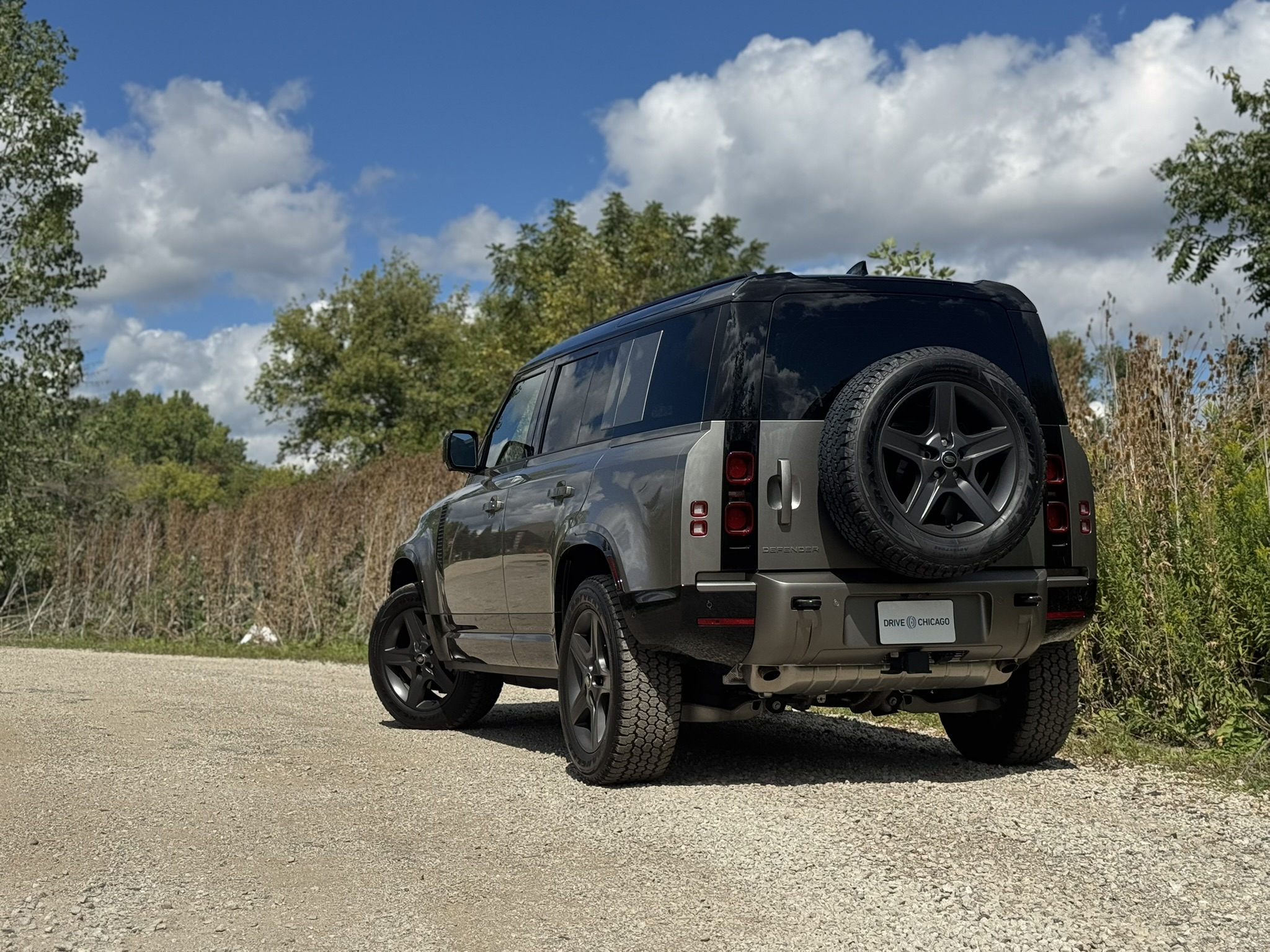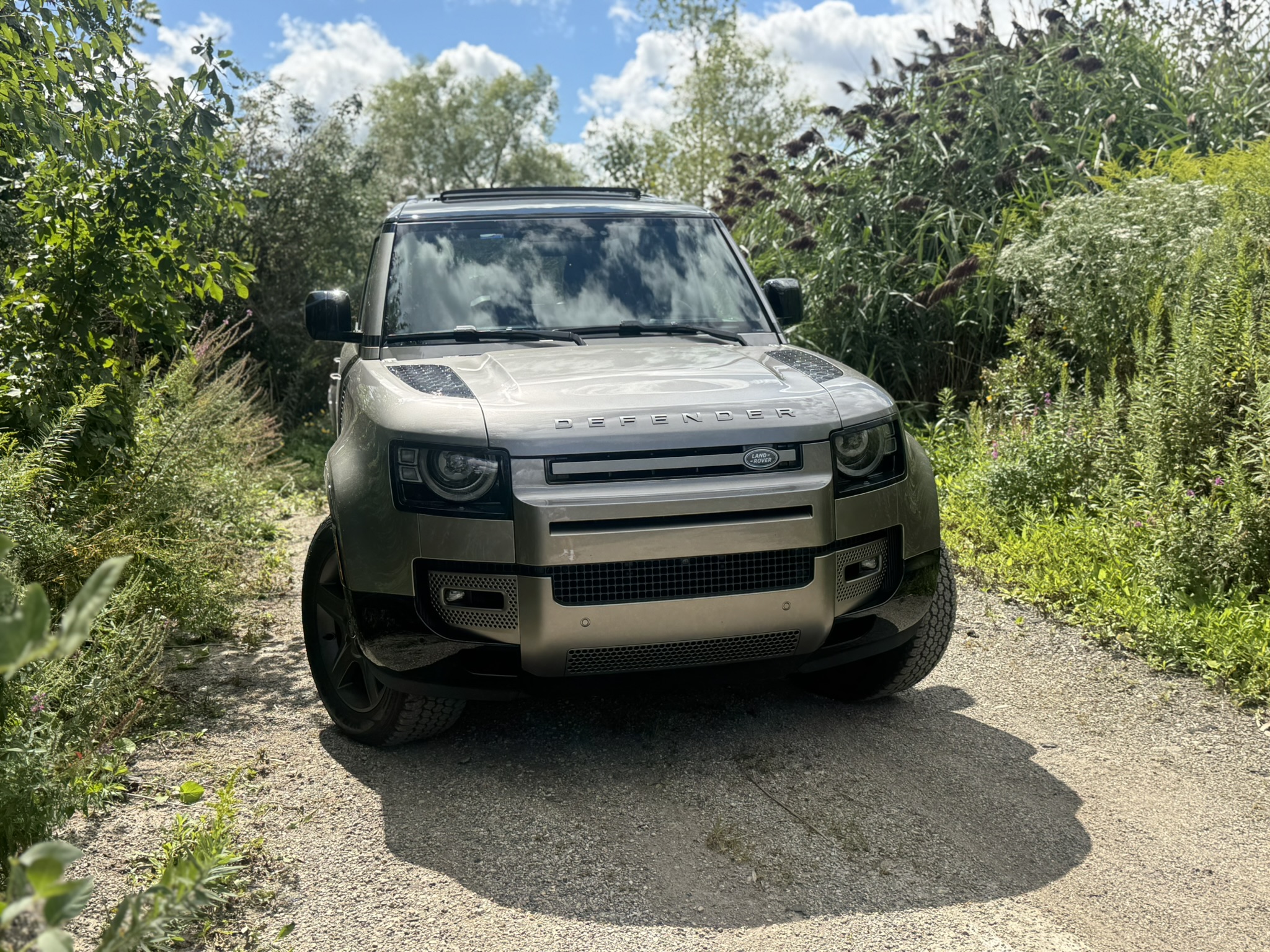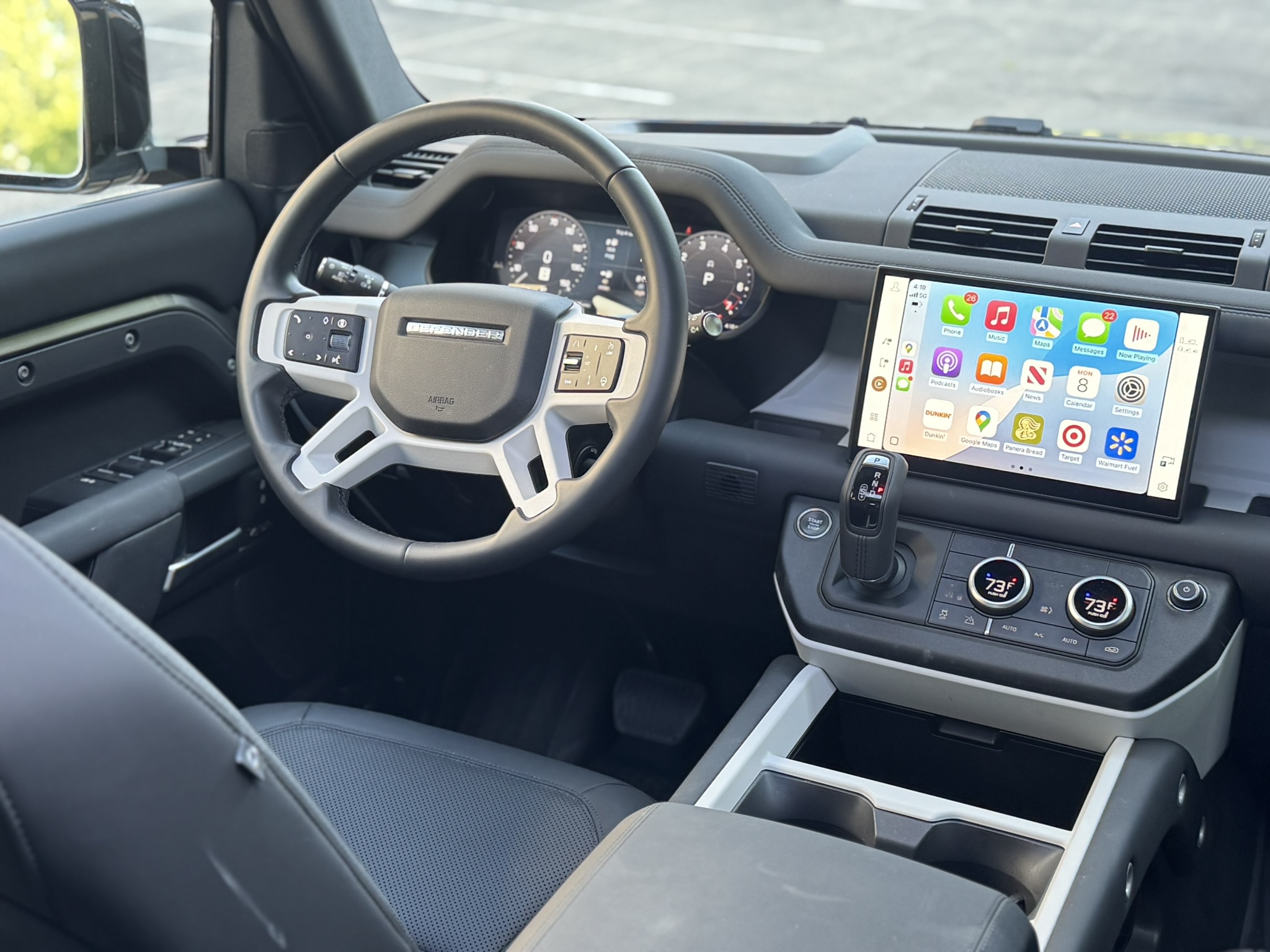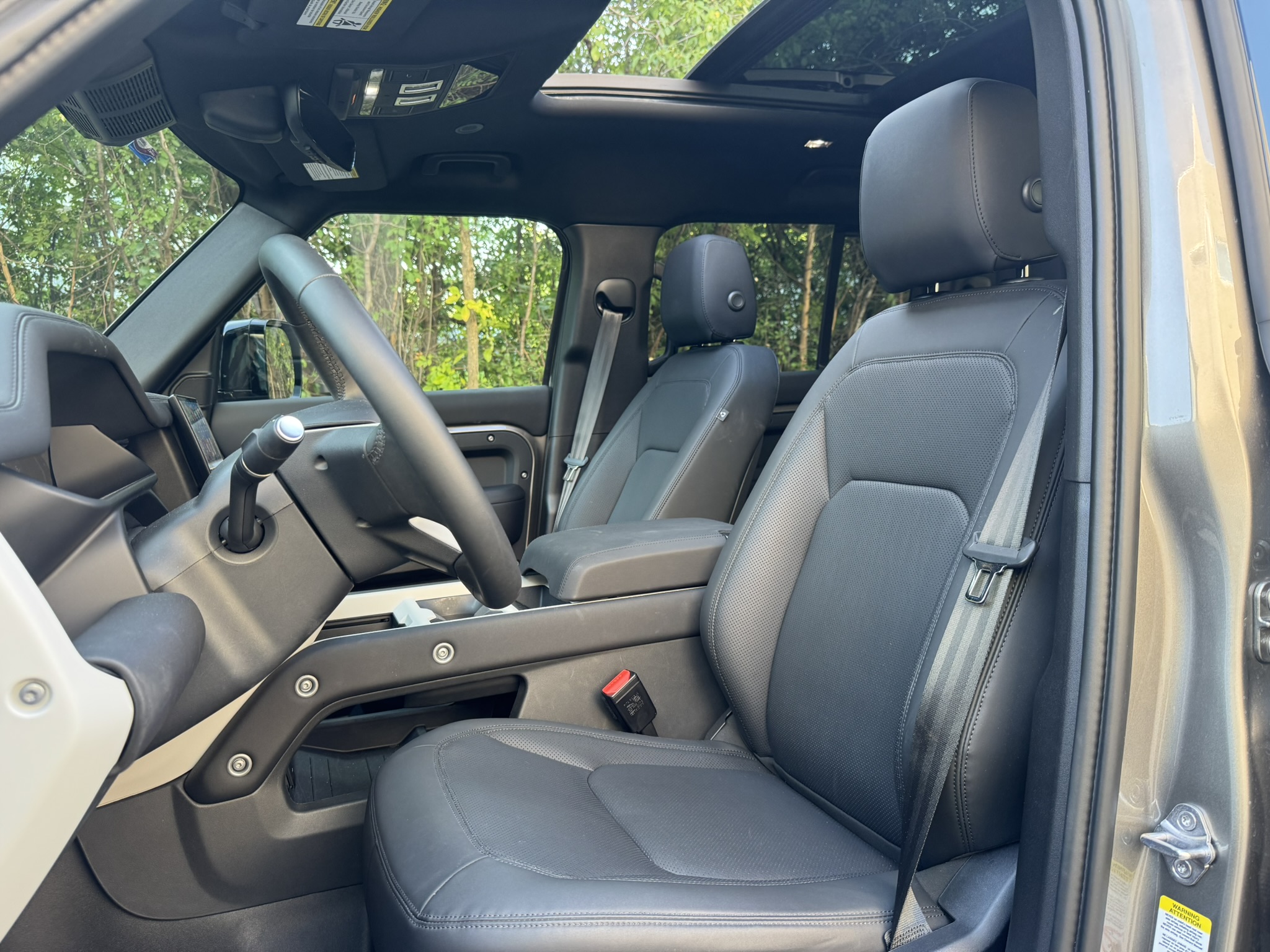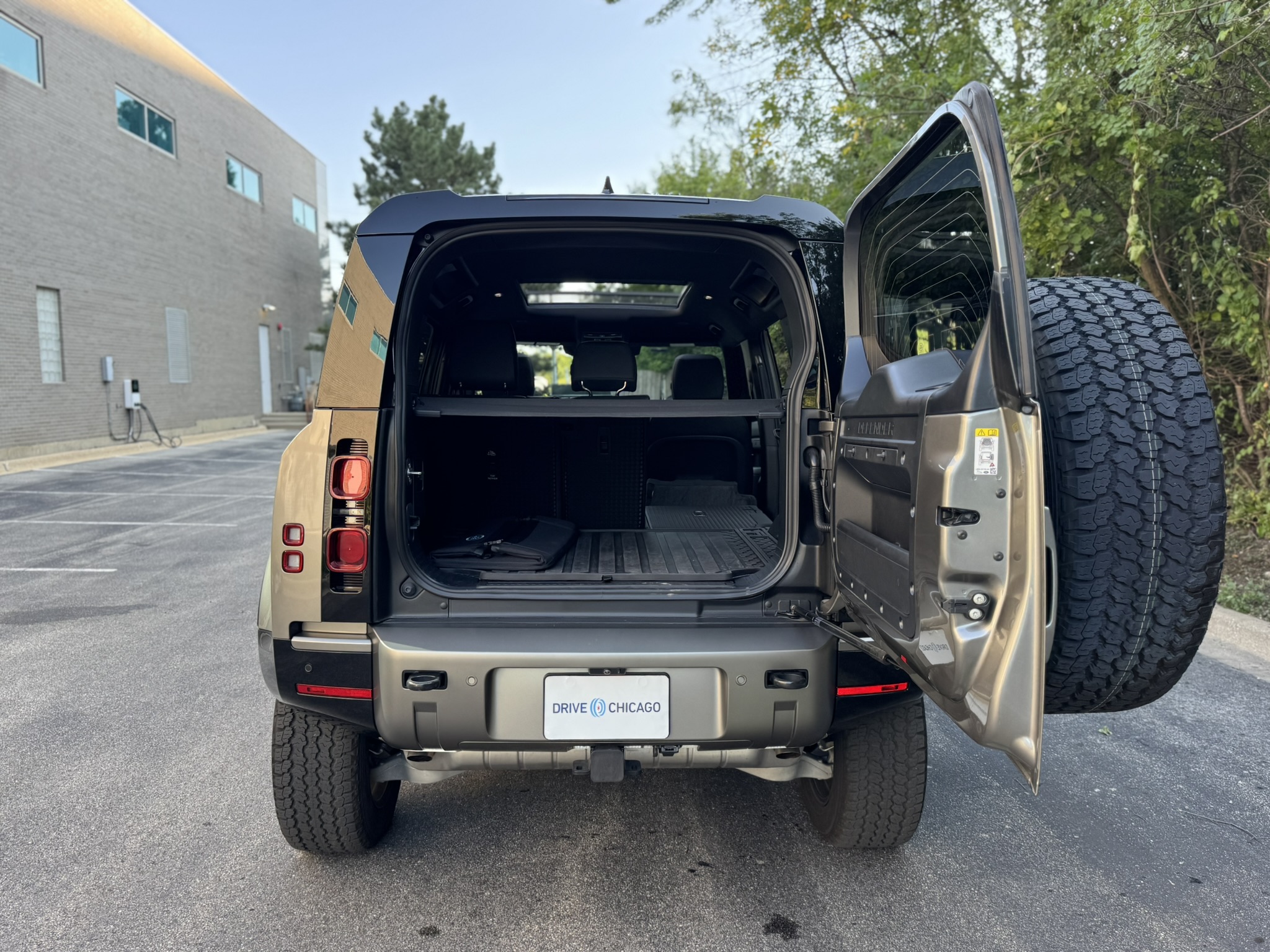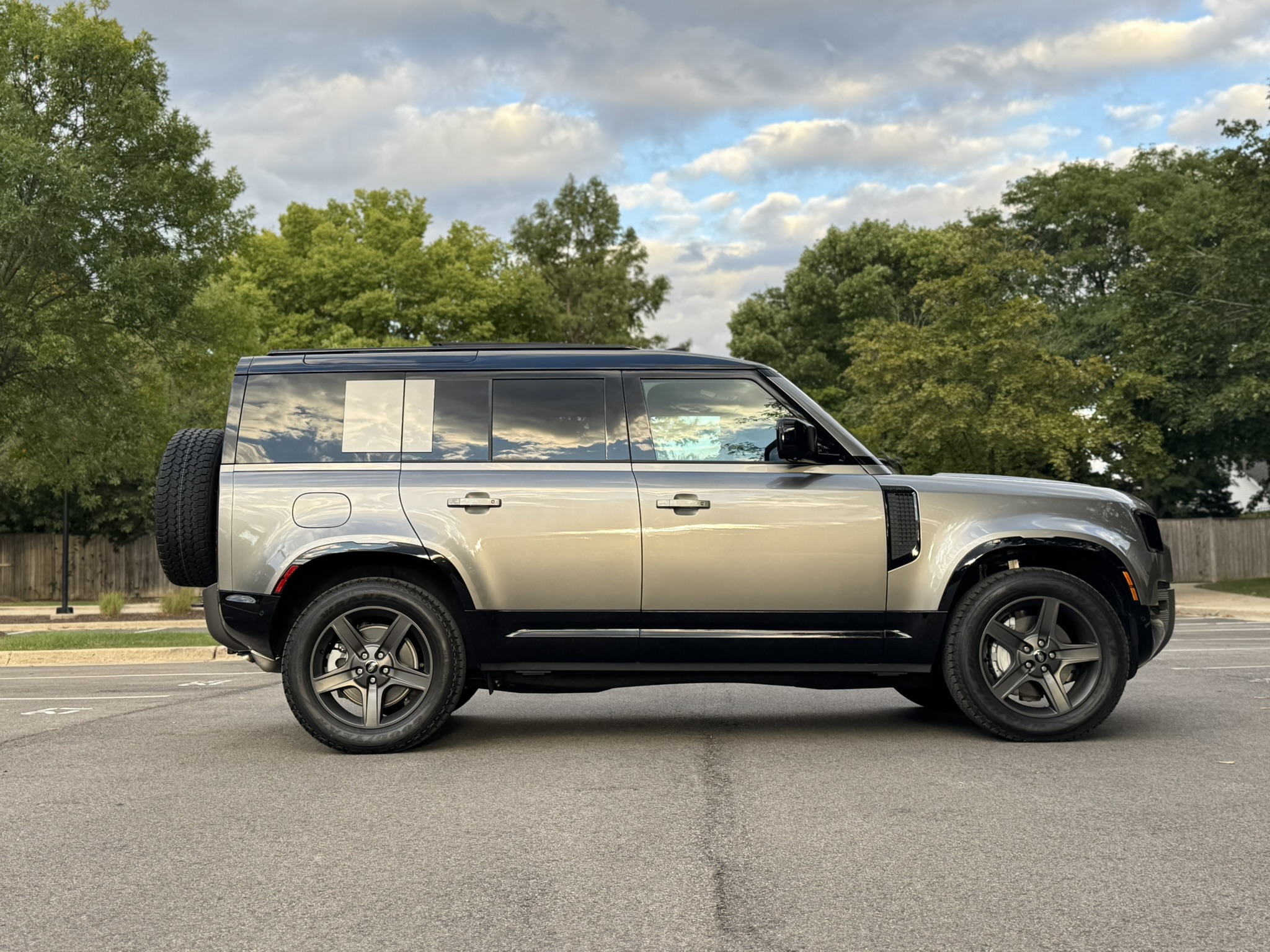2025 Land Rover Defender
An iconic off-roader enhances its performance while staying true to its roots
Test Vehicle:
2025 Land Rover Defender 110 X-Dynamic SE
Powertrain: MHEV 3.0L 6 Cylinder Gas Engine
Exterior Color: Silicon Silver
Interior Color: Ebony Leather
Options: Cold Climate Pack ($500), Off-Road Pack ($1,735), Towing Pack ($1,850), Air Suspension Pack ($1,600), Silicon Silver Paint ($1,550), Head-up Display ($1,000), Heated Rear Seats ($500), WiFi Enabled with Data Plan ($360), Emergency Pack ($75), Air Quality Sensor ($100), Premium Interior Protection and Storage Pack ($720), Three-Zone Climate Control ($400), Abin Air Purification ($375), Basic Rear Seat Convenience Pack ($265), Wheel Protection Package ($240), Handover Pack ($28)
MSRP as tested: $85,023 (With Delivery/Destination
Pros: Powertrain options, Capability, Balanced Road manners, Available options
Cons: Low fuel economy, High Cost, Reliability Concerns
The Land Rover Defender has roots that date back to 1983 when it was initially launched as the Land Rover 90 and 110 and was in production through 2016. The current Defender was relaunched for 2020 as a 4WD unibody-based SUV aiming to be more upmarket than its predecessor. The 2025 Land Rover Defender introduces a range of updates enhancing its performance, comfort, and technology, while maintaining its rugged off-road capabilities.
It is now available in three body length options, marketed as the Defender 90 (3-door), Defender 110 (5-door) and Defender 130 (5-door with extended rear overhang for three-row seating). New for 2025 is the addition of the Defender Octa and a simplified trim lineup. Focusing on the 110, it is available in five primary grades known as S, X-Dynamic SE, X, V8, and Octa. Land Rover now offers even more accessory packs that include the “Explorer Pack”, “Adventure Pack”, “Urban Pack” with updated options (black roof rack, cross bars, rear scuff plate in dark finish) to better tailor the Defender for its use case.
It's available with four different powertrains:
* P300 - Intercooled Turbo Premium Unleaded I-4 that generates 295 horsepower with 296 pound-feet of torque. (110 S)
* P400 - Intercooled Turbo Mild Hybrid I-6 that generates 395 horsepower and 406 pound-feet of torque. ( X-Dynamic SE, and X)
* P500 - Intercooled Supercharged Premium Unleaded V8 that generates 518 horsepower and 461 pound-feet of torque. (V8)
* Octa - 4.4L Turbocharged V8 that generates 626 horsepower and 553 pound-feet of torque
The Defender 110 is also available in two Trophy Edition models in either Sandglow Yellow or Keswick Green. Seating configurations for 5 or 7 are both available in the 110. Prices start at $63,500 for a base Defender S and can climb as high as $158,300 to start for a Defender Octa. Add some accessories to the Octa model and you could top $200k. Competition includes vehicles like the Ford Bronco, Jeep Wrangler, INEOS Grenadier, Lexus GX, and Mercedes-Benz G-Wagon. I spent a week in a 110 X-Dynamic SE with a long list of optional equipment that checked in at $85,023 and here's what stood out...
Exterior Style
The Defender is an easily recognizable vehicle that stands out with a unique design. The 110 is the mid-size version while the Defender 90 is the short 2-door model and the 130 is the extended length model. New for 2025 is a revised headlight signature and new fog lights that are standard on most models. Up front you'll see DEFENDER spelled across the hood flanked by round LED lighting and a mixed finish front fascia. The front corners are rounded to the fenders that flare out over the wheels. The hood features two textured panels (new patterns for 2025) and embedded in the fenders are grated air vents. From the side, you'll notice its tall, boxy stance with a clean, but prominent silhouette. Details such as the curved fixed glass in the roofline and panel on the C-pillar give it character. Around back you'll find the spare tire attached to the rear swing door. Eight square LED lights make it stand out at night as well. The lights are smoked with a darker tint and are flush fitting. Land Rover expanded the exterior color palette with two new colors known as Borasco Grey and Woolstone Green.
As mentioned, the Defender is available with a wide variety of exterior packages and options to further find a look that suits your taste. The County Exterior Pack includes a two-tone paint finish with a contrast roof and silver bumpers. It also features retro graphics that extend from the rear wheels to the front doors. 20" Gloss White steel-looking wheels completed the retro look on a modern vehicle. It is available in a few color packages that include:
- Fuji White body with new Tasman Blue Contrast Roof, plus Tasman Blue gradient graphic decal and treadplate.
- Santorini Black body with new Tasman Blue Contrast Roof, plus Tasman Blue gradient graphic decal and treadplate.
- Tasman Blue body with White Contrast Roof, plus Fuji White gradient graphic decal and treadplate.
In addition to the County Pack, there is a Black Exterior Package that adds Narvik black front and rear skidpans, gloss black badging, and a gloss black hood finisher. In a segment filled with options, this stands out aesthetically.
Wheel Options
The Defender is available with a wide variety of wheel options that vary in size from 19" up to 22". There are over 10 different styles available in a variety of finishes and colors. Whether you want standard silver, matte gray, gloss black, or the aforementioned steel white wheels, they are all available on the various grades of Defender. Also standard is a full-size spare thanks to the rear mount and all-season tires. New wheel designs for 2025 include a 22-inch seven-spoke Diamond Turned Dark Grey alloy.
Powertrain
I spent time with the mild hybrid 3.0L V6 that churns out 395 horsepower and 406 pound-feet of torque. It feels powerful for a heavy SUV and has enough oomph to get from 0-60 MPH in around 5.8 seconds. I loved driving this vehicle as it is well-poised on and off the road with plenty of power. Reviews of the lesser powerful P300 powertrain also convey good road manners, but I appreciated having a little more power. It delivers a smooth ride that is comfortable for everyday driving and longer trips. There was plenty of power for merging on the highway and passing other vehicles. Acceleration is smooth with the 8-speed automatic as it shifts exactly as it should. It remains composed around corners with confidence. There's minimal body lean, and steering is direct and responsive. It feels much more refined than other offroad vehicles such as the Ford Bronco or Toyota 4Runner but still maintains the truck-like ruggedness behind the wheel. Land Rover infused the Defender with a healthy dose of luxury refinement that has boosted this vehicle among my Top 10, maybe even Top 5 of all the vehicles I've driven.
Drive Modes
The Land Rover Defender 110 has several driving modes, including on-road modes and off-road modes:
- Normal driving: For driving on pavement or asphalt.
- Comfort: For long road trips, this mode provides a smooth driving experience.
- Eco: This mode adjusts the vehicle's settings to help reduce fuel consumption.
- Grass/Gravel/Snow: For firm surfaces that are slippery, such as icy conditions.
- Mud & Ruts: For soft, muddy, waterlogged, or rutted ground.
- Sand: For soft, dry, sandy ground, such as sand dunes and deserts.
- Rock Crawl: For off-roading.
These modes can be selected by turning or pressing a dial on the vehicle's central controller. They adjust the vehicle's power delivery, transmission settings, steering feel, ride height, and damping to provide better traction and clearance on different surfaces.
Capability
Land Rover developed the Defender with full capability in mind. From traversing through sand, water fording or climbing rocks, this is a vehicle that can do it all. It has a towing capacity of up to 7,716 pounds and is available with advanced tow assist that allows you to reverse a trailer while the SUV counter steers. Its roof load can accommodate up to 370 pounds while in motion and when parked up to 661 pounds. So, if you want to add a rooftop tent and camp above, the Defender can accommodate it. It can also wade through 35 inches of water and has enough power to winch with a maximum pulling force of 10,000 pounds.
New for 2025 is the introduction of Adaptive Off-Road Cruise Control (for the first time on Defender) as an option. The system allows the driver to set a desired comfort level off-road, and the vehicle adjusts speed accordingly over uneven terrain, helping reduce driver fatigue.
For $1,550 an optional off-road pack can be added which upgrades the Defender with an electronic active differential, domestic plug sockets, and off-road tires. Also available is an air suspension pack ($1,600) that allows for electronic adjustability and adaptive dynamics. Add in features such as the 3D surround camera among others and you're set for the ultimate overlanding expedition. And if you really want to go off the beaten path, opt for the Defender Octa which can basically be built as an Overlanding rig right from Land Rover.
Fuel Economy
If there's a fault in the Defender, then it lies with its overall fuel economy. It arrived with a full 23.8-gallon tank that offered a range of around 400 miles. EPA estimates 17/20/18 MPG city/highway/combined. These ratings are low compared to other midsize luxury SUVs, but on par with other off-road oriented unibody vehicles. Premium fuel is recommended
Interior
Hopping inside, the Defender blends rugged durability with premium features. It's not as posh as a Mercedes or Lexus, but the build and functionality fall right in the sweet spot. A new 13.1‑inch touchscreen (up from 11.4”) for the infotainment system brings all of Defender’s technology highlights to the front‑row occupants via a larger display, above the ergonomically repositioned dash‑mounted gear shifter. Design touches like an exposed magnesium cross-car beam across the dashboard add character and reference the Defender’s heritage. The dash features a ledge that runs from the steering wheel behind the touchscreen and across the passenger side. This useful space is helpful for sunglasses, mobile devices and other items... especially on a longer road trip.
It has a joystick-like electronic gear shifter that is at arms' length protruding from the dash and intuitive controls for climate. The center console features a wireless charging tray, cupholders, storage compartment and an additional storage tray underneath. There’s a new sliding section of the center console that hides small items out of sight in a closed cubby while still maintaining access to deeper storage beneath. The cabin is also very open and airy thanks to large windows, a panoramic opening sunroof and the additional windows up top in the back.
Seating
With seating for five or seven passengers, Defender 110 offers flexibility to buyers. Partial leather upholstery, power-adjustable and heated front seats and a heated, leather-wrapped and power tilt-and-telescoping steering wheel come standard. Full leather upholstery, premium Windsor leather upholstery, leather and microsuede upholstery, ventilated front seats and heated second-row seats are available. There is plenty of head, leg, and shoulder room all around. The seats are supportive and comfortable for longer rides. The second-row bench accommodated my three kids with plenty of comfort. My test vehicle did not have the third row; however, I imagine it would be a tighter space in the 110. If you're in need of a regular third row, you should consider the extended Defender 130. One issue that drivers may need to overcome is rearward visibility as the rear-mounted tire does block the bottom of the window. While I'm willing to sacrifice that for the aesthetic appeal, it may be an issue. As a consolation, the Defender does come standard with a 360-degree camera that should help.
Technology
The 13.1" infotainment screen wirelessly connects with both Apple CarPlay and Android Auto. Other standard features include navigation, wireless device charging, a 10-speaker Meridian audio system, USB ports, dual-zone climate controls, and the panoramic roof. Physical controls remain for important functions (climate, drive/off-road modes), which is appreciated in a vehicle that might be used off-road. Options include things such as an air quality sensor, three-zone climate controls, ambient LED lighting, a center console refrigerator, and an activity key (a wearable wristband that lets you lock and unlock the vehicle without a key fob). There’s also a new Driver Attention Monitor camera (driver-facing) to track alertness and provide a warning if the system senses reduced focus.
My test model also had a cold climate pack ($500) that added a heated windscreen, heated washer jets, and a headlight power washer. I found the technology to be intuitive and responsive. It had everything I'd expect and then some.
Cargo Space
When configured as a two-row model, the 110 offers 34 cubic feet behind the second row and 78.8 cubic feet with the seats folded flat. The three-row version has 10.7 cubic feet behind the third row, 34.6 cubic feet behind the second row and 69 cubic feet with both rows folded down. The rear door swings open which may be a challenge in urban environments, but it does make loading/unloading easy. The squared-off body means the cargo area is fairly boxy and usable all around.
Safety
The Defender comes with a long list of standard safety & security features that include:
- Automated Emergency Braking
- Lane-Keep Assist (and/or Lane-Departure Warning) with steering help
- Blind Spot Assist.
- Adaptive Cruise Control
- 3D Surround Camera / 360-degree Parking Aid system
- Rear Traffic Monitor
- Traffic Sign Recognition & Adaptive Speed Limiter
- Driver Condition Monitor (detects fatigue/distraction)
Beyond the standard features, there are more capability and premium safety/assistance features that may come only on higher trims, or as part of optional packages. These features include Wade Sensing, ClearSight Rear-View Mirror and Ground View, and more advanced off-road camera views. The Defender has no current NHSTA crash test ratings but has earned 5-star NCAP ratings in Europe.
Final Statement
As someone who likes unibody, truck-based SUVs, I knew I would like the Defender. It perfectly blends the luxury and convenience features in a luxury SUV with the raw, simpleness of a vehicle you want to get dirty. It felt comfortable as a daily driver and aside from the low fuel economy I found it hard to find faults. It can get pricey, but so can a Jeep Wrangler and you get a lot more luxury elements with the Defender. If your priority is a luxury-level SUV that can genuinely go off-road (and you’ll use that capability) and you’re comfortable with premium pricing and running costs — the Defender 110 is very compelling. If instead your priority is maximum on-road sportiness, minimal cost of ownership, or you don’t care at all about going off-road — then there might be more suited vehicles out there (or opt for a lower trim) where you trade some off-road ability for better value or efficiency.
